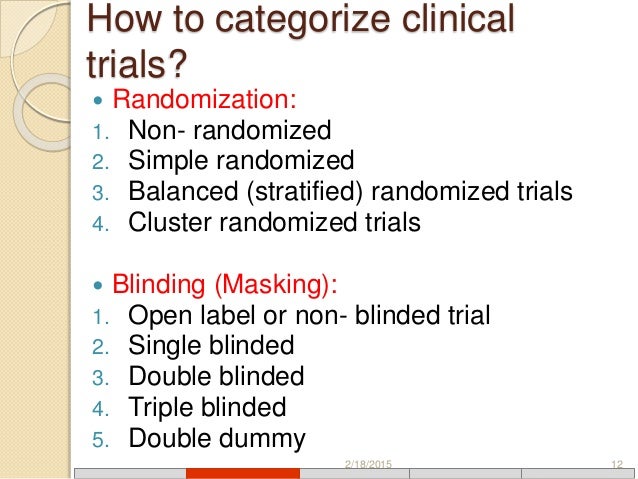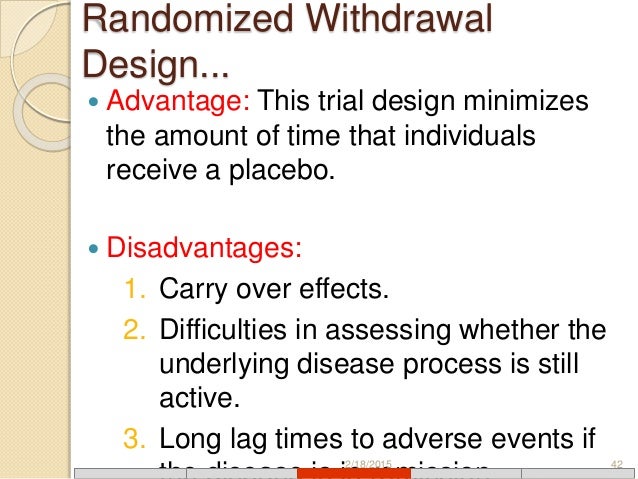38 open-label study disadvantages
Effectiveness studies: advantages and disadvantages - PMC Disadvantages: - Stringent inclusion criteria limit external validity - Outcome measures may not reflect crucial advantages and limitations of Interventions being studied - Outcome measures may not address issues most important to patients and families - Often short in deration Open in a separate window (PDF) What is an open label trial? - ResearchGate this was an open label trial, the participants, investigators, and all peripheral staff were not blinded to the treatment allocation—that is, they were aware which treatment the participants had...
Epidemiology and Clinical Research Design, Part 1: Study Types. It is difficult to ensure that the exposed and control groups have the same risk of outcome (other than the exposure). In addition to known baseline characteristics for which the exposed and control groups are matched, there may be unknown prognostic factors that are unevenly distributed in the 2 groups contributing to the outcome.

Open-label study disadvantages
Understanding Clinical Trial Terminology: What is an Open Label ... Often, clinical trials use a double-blind approach: study participants and researchers don't know which treatment the patient is receiving. Alternatively, sometimes, trials are conducted in an open-label fashion, meaning study participants and researchers both know which treatment the patient is receiving. PDF Blinding Sponsors for Open Label Studies: Challenges and Solutions - MWSUG the study is ongoing. The practice helps increase credibility of study results and thus should be followed, particularly for registration studies. In open label studies, in addition to treatment assignment data itself, many other data elements in the CRF data can reveal treatment assignment. Those data elements include (but not limited to): • External and internal validity of open label or ... - Wiley Online Library Naturally, in open-label trials in anticoagulation there is a risk of a reporting bias of adverse events. Patients may research the new drug and its side-effects in publications and may be influenced in their reporting behaviour of potential side-effects. Furthermore, investigators may be equally susceptible to a reporting bias.
Open-label study disadvantages. Open-label versus double-blind placebo treatment in irritable bowel ... Here, we will briefly review the academic literature on the traditional use of blinded placebos, discuss recent research using open-label placebo (OLP), and describe the methodology and rationale for our current RCT, which was designed to compare open-label and double-blind placebo (DBP) in a sample of participants with irritable bowel syndrome ... Investigating Potential Bias in Patient-Reported Outcomes in Open-label ... At the same time, randomized oncology trials are increasingly open-label, and the accelerated approval pathway is frequently sought for oncology products based on single-arm trials. 7 Rigorous characterization of symptoms and function using PRO measures can complement current trial outcomes, and this information may be incorporated into ... Reducing bias in open-label trials where blinded outcome assessment is ... This can be an issue in trials assessing surgical interventions, device trials, or other non-pharmacologic interventions, which are more difficult to blind than traditional drug trials [ 4 ]. Many such trials are therefore open-label, where patients, clinicians, and care providers are aware of treatment allocations. PDF What Are Open-Label Extension Studies For? In open-label assessment studies, there is a sig-nificant risk of biased assessment. Analysis of all subjects who were randomized (intent to treat analysis) is another important technique, since subjects who drop out can differ in crucial ways from subjects who remain in the study. In open-label extension studies, only a proportion of the sub-
Open-label extension studies: do they provide meaningful information on ... Negative aspects of open-label extension studies revolve around their use as a marketing tool, as they build a market for the drug and generate pressure for subsidised access to the drug from consumers and their physicians. Pilot Studies: Common Uses and Misuses | NCCIH Feasibility measures are likely to vary between "open-label" designs, where participants know what they are signing up for, versus a randomized design where they will be assigned to a group. In addition to providing important feasibility data as described above, pilot studies also provide an opportunity for study teams to develop good ... External and internal validity of open label or ... - Wiley Online Library In general, a blinded trial is regarded as being less subject to bias than an open trial because it minimizes the impact of knowledge of treatment allocation on post‐randomized treatment decisions and on reporting of outcomes. However, a blinded trial is not always feasible. External and internal validity of open label or double-blind trials in ... In general, a blinded trial is regarded as being less subject to bias than an open trial because it minimizes the impact of knowledge of treatment allocation on post-randomized treatment decisions and on reporting of outcomes. However, a blinded trial is not always feasible.
What is an open label trial? | The BMJ In an open trial, ascertainment bias can also occur on behalf of the participants. Participants know their treatment allocation and, for example, might be disappointed if not allocated their preferred treatment, with the result that they report worse scores for the outcome measures than were experienced. Open-label trial - Wikipedia An open-label trial, or open trial, is a type of clinical trial in which information is not withheld from trial participants. [1] In particular, both the researchers and participants know which treatment is being administered. [1] This contrasts with a double-blinded trial, where information is withheld both from the researchers and the ... Open-Label & Single-Blind Studies - Levien Flashcards | Quizlet 6 Disadvantages to Open-label techniques 1. Subject to what? 2. Issue with selection bias? 3. Issue about it being easier to get more patients? 4. Psychological effects of what? ... Do open-label studies have this? A) Related to randomization when the study assignment group is concealed from individual recruiting subjects B) They can and should ... Effects of open-label placebos in clinical trials: a systematic review ... These trials assessed effects of OLPs on back pain, cancer-related fatigue, attention deficit hyperactivity disorder, allergic rhinitis, major depression, irritable bowel syndrome and menopausal...
14 Advantages and Disadvantages of a Randomized Controlled Trial List of the Advantages of Randomized Controlled Trials. 1. Randomization prevents the deliberate manipulation of results. A randomized controlled trial works to prevent skewing or the deliberate manipulation of results by researchers or participants. Because each subject gets assigned to a specific group randomly, the removal of choice works to ...
NCI Dictionary of Cancer Terms NCI's Dictionary of Cancer Terms provides easy-to-understand definitions for words and phrases related to cancer and medicine.
Reducing bias in open-label trials where blinded outcome assessment is ... This can be an issue in trials assessing surgical interventions, device trials, or other non-pharmacologic interventions, which are more difficult to blind than traditional drug trials [ 4 ]. Many such trials are therefore open-label, where patients, clinicians, and care providers are aware of treatment allocations.
Open-Label Trial - an overview | ScienceDirect Topics Open-label studies lack the rigor of blinded studies. Since the lack of blinding can introduce significant bias, reserve the use of open-label studies for situations in which blinding is neither feasible nor ethical or in cases where the outcome is completely objective, such as survival. Some situations include: •
Study designs — Centre for Evidence-Based Medicine (CEBM), University ... An experimental comparison study in which participants are allocated to treatment/intervention or control/placebo groups using a random mechanism (see randomisation). Best for study the effect of an intervention. Advantages: unbiased distribution of confounders; blinding more likely; randomisation facilitates statistical analysis.
Cytokinetics Announces Start of Open-Label Extension Study for Patients ... COURAGE-ALS OLE: Clinical Study Design. COURAGE-ALS OLE is an open-label extension clinical study of reldesemtiv in people with ALS who have completed participation in COURAGE-ALS. Following ...
Open-Label Extension Studies | SpringerLink The number of open-label extension studies being performed has increased enormously in recent years. Often it is difficult to differentiate between these extension studies and the double-blind, controlled studies that preceded them. If undertaken primarily to gather more patient-years of exposure to the new drug in order to understand and gain confidence in its safety profile, open-label ...
Open-Label Trial | NIH In open-label trials, both the researchers and participants know which drug (or other intervention) is being given to participants. Skip to main content Get the latest public health information from CDC ... Double-Blind Study. Print. Print this term. Download Glossary. English Version PDF(3.13MB) Spanish Version PDF(3.16MB) Connect with us ...






Post a Comment for "38 open-label study disadvantages"